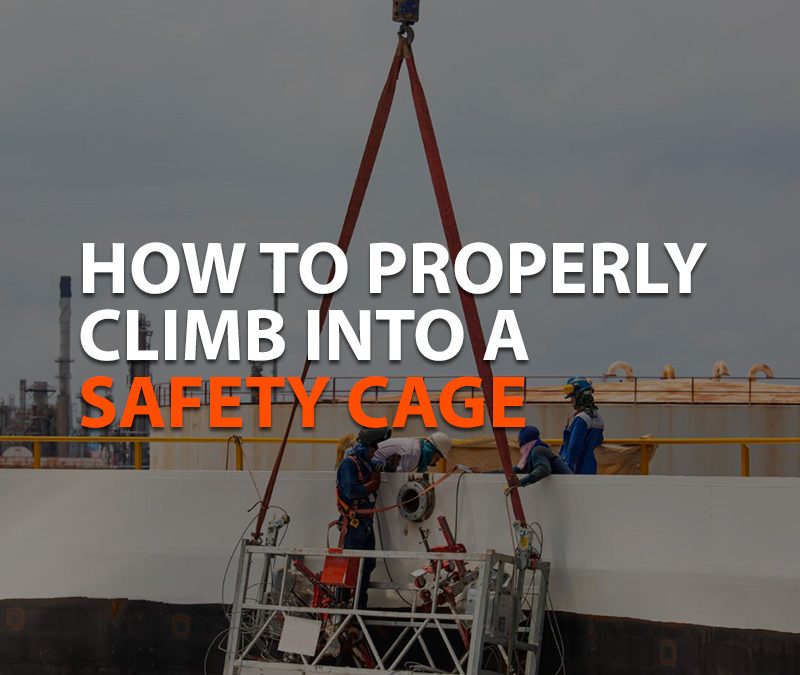Working in the bustling world of ports and harbors comes with its own set of risks and challenges. Stevedores, the dedicated professionals responsible for loading and unloading cargo, often encounter hazardous environments that demand utmost caution. One critical aspect of port safety is the proper utilization of safety cages when ascending and descending vessels or machinery.
This article aims to provide stevedores and port workers with essential guidelines on how to safely climb into a safety cage, ensuring their well-being and the overall safety of the port environment.
- Understand the Purpose of Safety Cages:
- Wear Appropriate Personal Protective Equipment (PPE):
- Perform a Pre-Use Inspection
- Communicate and Coordinate
- Maintain Three Points of Contact
- Ascend and Descend Steadily
- Secure the Safety Cage Door
- Avoid Overloading
- Report Safety Concerns
- Conclusion
Understand the Purpose of Safety Cages:
Safety cages, also known as lashing cages, man cages or personnel baskets, are designed to provide a secure enclosure for workers during vertical transportation. They are typically used when accessing heights using cranes, hoists, or other lifting equipment. Safety cages serve as protective barriers, preventing falls and ensuring the safety of individuals while working at elevated levels.
Do you want to learn more about safety cages technical specifications?

Wear Appropriate Personal Protective Equipment (PPE):
Before attempting to climb into a safety cage, it is crucial to don the necessary personal protective equipment. This includes a hard hat, safety goggles, high-visibility clothing, and steel-toed boots. PPE acts as a vital defense against potential falling objects, impact hazards, and other risks associated with port operations.
Perform a Pre-Use Inspection:
Before entering a safety cage, stevedores must conduct a thorough inspection to ensure its proper functioning and structural integrity. Check for any signs of damage, such as dents, cracks, or loose components. Verify that the access gate or door is in good working condition, and confirm that the cage is securely attached to the lifting equipment.
Communicate and Coordinate:
Clear communication and coordination between the stevedores and the crane or hoist operator are paramount. Establish effective communication protocols, such as hand signals or radios, to relay instructions and alerts. The crane operator should be aware of the stevedores’ readiness before initiating any lifting operations.
Maintain Three Points of Contact:
When climbing into a safety cage, always maintain three points of contact with the structure. This means having two hands and one foot or two feet and one hand in contact with the ladder, steps, or handrails at all times. This practice ensures stability and reduces the risk of slipping or falling during the ascent.
Ascend and Descend Steadily:
While entering or exiting the safety cage, proceed with caution and avoid rushing. Ascend or descend the ladder or steps one at a time, using a controlled and deliberate movement. Never skip steps or make sudden movements that could compromise your balance or safety.
Secure the Safety Cage Door:
Once inside the safety cage, ensure that the access gate or door is properly closed and securely latched. This prevents accidental openings during transport, minimizing the risk of falls or ejections.
Avoid Overloading:
Safety cages have specified weight limits that should never be exceeded. Adhere to these limits and avoid overcrowding the cage. Overloading can compromise the stability of the lifting equipment and increase the risk of accidents. If multiple workers need to be transported, use multiple safety cages or consult with the crane operator for alternative solutions.
Report Safety Concerns:
If any safety issues or concerns regarding the safety cage are identified, report them immediately to the appropriate authority or supervisor. Defective or damaged safety cages should not be used until they are repaired or replaced to ensure the safety of all personnel.
Conclusion:
Climbing into a safety cage is a routine task for stevedores and port workers, but it should never be taken lightly. The safety of stevedores and port workers is of utmost importance in the maritime industry. Climbing into a safety cage requires careful adherence to safety protocols and best practices to minimize the risks associated with vertical transportation.
If you want to increase your worker’s safety and prevent risks, take a look at our safety cages and lashing equipment.






